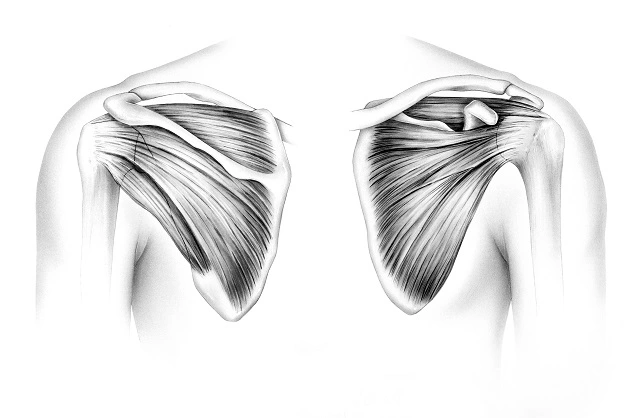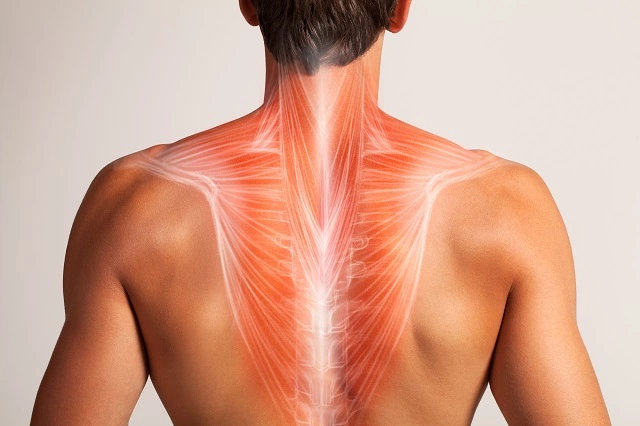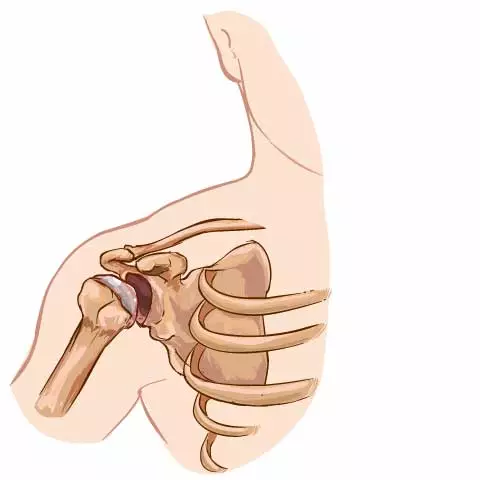As a physical therapist, I see many patients who come with complaints of shoulder pain. I am often surprised at the discrepancy from what the patient perceives to be a shoulder issue and what I consider the actual shoulder or glenohumeral joint to be. Some people have pain in the upper trapezius muscles and consider it a shoulder problem. Some people complain of pain in the posterior shoulder blade (scapula) region that they call shoulder pain. I always make sure that we agree on what part of their body is affected, even though it may differ from what I consider a shoulder joint.
To illustrate what I mean, here are a couple of pictures:
Scapula / shoulder blade- not a shoulder

The scapula, commonly called the shoulder blade, can be a source of pain for people, but it is not the shoulder. However, patients often interpret pain near the scapula as shoulder pain.
Upper trapezius – also not a shoulder

The trapezius is a large, triangular shaped muscle that extends from the base of the skull down to the mid-back, and across to the back of the shoulder. Often, individuals with upper trapezius pain or dysfunction will interpret their pain as shoulder pain.
Glenohumeral joint Yes, that’s a shoulder

The glenohumeral joint is the most mobile joint in the human body, with a plethora of functions and numerous muscles connecting to it. Pain in this joint is truly shoulder pain.
The shoulder is a very dynamic ball and socket joint that is not a very deep socket. It is held in place primarily by the muscles and tendons around the joint. The hip joint is also a ball and socket joint but its socket is much deeper and more stable. The hip ball and socket joint, due to being more stable, is less mobile. This means it does not move as far and as freely but is less likely to come out of its socket. The shoulder joint is much less stable due to its shallow socket. As mentioned above, it is much more mobile. You can’t have stability and mobility in these joints. In anatomy, you usually sacrifice one for the other.
Scapular stability for shoulder pain relief
From experience I have learned that most patients suffering from shoulder symptoms can benefit from some level of treatment to the muscles of the scapula. Painful joints tend to cause tightness in the surrounding tissues and a painful shoulder will regularly affect the scapular muscles. Stretching of the scapular muscles can be mildly to significantly beneficial to the shoulder as muscles and tissues move in concert together to accomplish smooth and coordinated patterns of the arm.
The humerus rests in the shallow joint space that arises from the scapula (shoulder blade). The mobility of the shoulder joint is dependent on a stable base of support from the scapula. Instability of the scapula can result in an unstable shoulder joint putting stress on the soft tissues. Lack of scapular muscle development can contribute to shoulder dysfunction and shoulder symptoms.
A common way to visualize this is to discuss crawling. Crawling is an important part of the human development process and also critical for the development of scapular muscles which are used regularly when we put weight on our hands while crawling. Children who learn to walk early are predisposed to have shoulder issues later in life due to lack of scapular muscle development that is needed for shoulder activities such as throwing.
Stretching for shoulder pain relief
Whether you have true “shoulder pain” or you’re doing this stretch for shoulder blade pain, you can expect some quick relief. Stretching is beneficial to many areas of the body. Here is a simple one to get you started. One of the primary stretches I recommend for the shoulder and scapula can be done with the use of a kitchen or bathroom cabinet as follows:
Open the lower cabinet door. Bend at the waist to ~90 degrees near the cabinet opening so that your body is parallel to the cabinet’s countertop surface. Reach across the body with the outside arm to grab the horizontal frame of the cabinet and hold on. Lean your body weight away from and perpendicular to the cabinet moderately until you feel a stretch occurring along the inside of the scapula. You can adjust the angle of your weight away from the cabinet slightly to change the tension around the scapular slightly. Stretches are most effective when there is tension noted by not to the point of pain for >20 seconds. Do not perform this stretch if it hurts. A tight stretch is good. Pain is not. Reducing tension around the scapula allows for greater freedom of movement of the shoulder joint to reduce stress to those tissues. Those stretches can be performed multiple times a day. Many people that work at computers all day long benefit from this stretch.
If you’ve still got shoulder pain
There are many other simple and complex issues that contribute to shoulder pain. Additionally, there are numerous shoulder stretches for pain that you could choose from.
One thing to note is that pain relief is not the same thing as healing. This stretch should provide you with some quick relief it you’re experiencing shoulder pain. I recommend you hold this stretch for 30-60 seconds a couple times per day. However, if you are experiencing significant or persistent shoulder problems, I recommend you get in touch with a physical therapist or medical provider for further direction.
For purposes of this article, I just wanted to keep it as a quick tip. If you are experiencing significant or persistent shoulder problems, call a physical therapist to discuss the condition of your shoulder to create a plan to help it feel and function better.

















